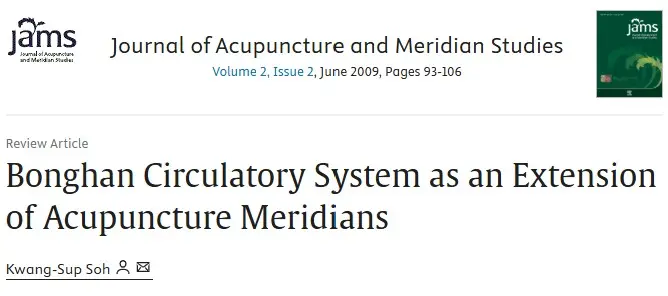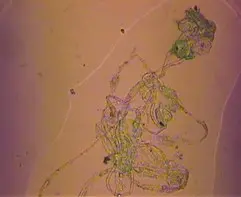Sanals and the
Primo Vascular System
Sanals are small subcellular bodies found within the Primo Vascular System (PVS). The PVS is also known as the Bonghan Ducts. Thread-like structures, often confounded with fibrin, appear to be Bonghan ducts under optical microscopy.
Sanals have been confirmed to function similarly to stem cells. They play a crucial role in the regeneration of cells, particularly in damaged tissues.

The Bonghan system is a newly-discovered circulatory system, which
corresponds to classical acupuncture meridians and was discovered in the early
1960s by Bonghan Kim. Despite its potential importance in biology and medicine,
it has been ignored or forgotten for a long time.
Only recently have most of
its significant parts, such as the Bonghan system (BHS) inside blood or lymph
vessels, on the surfaces of internal organs, and in brain ventricles, been
confirmed. For this, novel methods using modern technology were necessary
because Bonghan Kim did not describe his methods. For example, among other
methods, the discovery of a BHS-specific dye, trypan blue, was one of the most
important original contributions that made BHS observation possible. With this
technique, the BHS in adipose tissue became traceable, and the BHS was
discovered on the fascia surrounding tumor tissues, a finding which may have
great significance in relation to serious health problems in modern society,
namely, obesity and cancer.
Sanals have garnered attention for their unique nature and functions. Here’s a summary based on recent scientific literature:
Nature of Sanals
Size and Structure: Sanals are typically
around 1 to 2 micrometers in size. They are considered pleomorphic, meaning
they can change forms throughout their lifecycle.
According to Bonghan Kim, who discovered
the PVS, sanals are generated by cells through a process called sanalization. A
single cell can produce multiple sanals, which are then transported to primo
nodes (PNs) via primo vessels (PVs).
Function of Sanals
Cell Regeneration: Sanals play a crucial role in cellular regeneration. They express stem
cell biomarkers and have been shown to differentiate into various cell
types.
Hematopoiesis: Research indicates that sanals can participate in non-marrow
hematopoiesis, meaning they can produce blood cells outside of the bone marrow,
particularly in response to conditions like anemia.
Healing and Repair: Sanals have been linked to the repair of damaged tissues, including
neural tissues, suggesting their potential in regenerative medicine.
Sanals are transported through the Bonghan ducts to Bonghan corpuscles (BHCs), where they can form new cells. This process is part of what is termed the "Bonghan sanals-cell cycle," which involves both the formation of new cells (cellation) and the transport of sanals.
The physiological role of the Bonghan system, including sanals, is closely linked to cell therapy. The system is believed to facilitate healing and regeneration through the movement of DNA granules within the Bonghan ducts, which are essential for cellular development.
Staining techniques allowed to visualize the Bonghan ducts and Bonghan corpuscules or Sanals. There is evidence that the cells in the Bonghan ducts are highly electrosensitive, responding to electric, electromagnetic and even light signals (biophotons from DNA).
Abstract from Bonghan Circulatory System as an Extension of Acupuncture Meridians - ScienceDirect
“The circulatory function of the BH system also requires the existence of excitable cells, which can be tested using electrophysiological experiments. A BHC (sanal) obtained from rat intestinal surfaces was placed in a Locke's solution bath and a microcapillary electrode inserted into the BHC cell membrane, which showed an abrupt electrical potential drop of 40 mV relative to the reference potential followed by irregular bursts of spontaneously evoked spikes in the resting potential at an average duration of 16 seconds. The resting potential and pattern of irregular bursts showed smooth muscle-like excitability of the cells in the BHC. In addition, the irregular bursts showed some resemblance to certain firing patterns of neurons, which suggested a nerve-like electrical signal transmission in the BH system.”

So, what can impair this Bonghan sanals-cell cycle?
The functioning of the sanal-cell cycle can be disrupted by several factors:
1. Environmental Stressors: Factors such as toxins, pollutants, and radiation can negatively affect cellular processes, including the sanal-cell cycle. EMF radiation proved to impair the production of EZ water in our cells (Prof. Pollack). These stressors may lead to cellular damage and hinder regeneration.
2. Hormonal Imbalances: Research on the quality and contents of the liquid transporting sanals showed that hormones play a crucial role in regulating cell growth and division. Imbalances, such as insufficient growth hormones, can inhibit the sanal-cell cycle, affecting tissue repair and regeneration. The Sanal-Cycle is before anything a transport system (its speed was measured) with circulation in a liquid containing hyaluronic acid, neurotransmitter hormones such as adrenalin and noradrenalin, amino acids, and free nucleotides. The primary function of the Sanal Cycle is linked to tissue repair and hematopoiesis ( blood cell formation).
3. Chronic Diseases: Conditions such as diabetes, cancer, and cardiovascular diseases can interfere with the sanal-cell cycle by creating an unfavorable environment for cellular regeneration. It is precisely the kind of pathologies with the most significant improvements in the South Korean Healing Center.
4. Inadequate Blood Flow: Proper circulation is essential for delivering nutrients and oxygen to cells. Reduced blood flow can impair the function of sanals and hinder their regenerative capabilities. The radiant ceramics used in the healing protocol optimize the blood circulation by infrared radiation. This property and its efficacy was recognized by the American FDA who attributed a “Medical Device” label to textiles which had Qelby somatid based ceramic powder fused-in during production of the fiber.
5. Electromagnetic Interference: Some studies suggest that electromagnetic fields can influence cellular behavior. Disruptions in the electromagnetic environment may affect the sanals-cell cycle. Laboratory experiments proved that QELBY powder presents outstanding shielding properties for both non-ionizing radiation (like Wi-Fi, Bluetooth, cellular communications etc) AND for ionizing radiation . A full experiment in a Japanese nuclear plant was performed showing again good shielding properties for nuclear radiation.
Research Implications
The study of sanals is still evolving,
with ongoing research aimed at understanding their precise mechanisms and how
they contribute to health and disease. Their potential as a new type of stem
cell and their role in the PVS could represent significant advancements in regenerative
therapies.